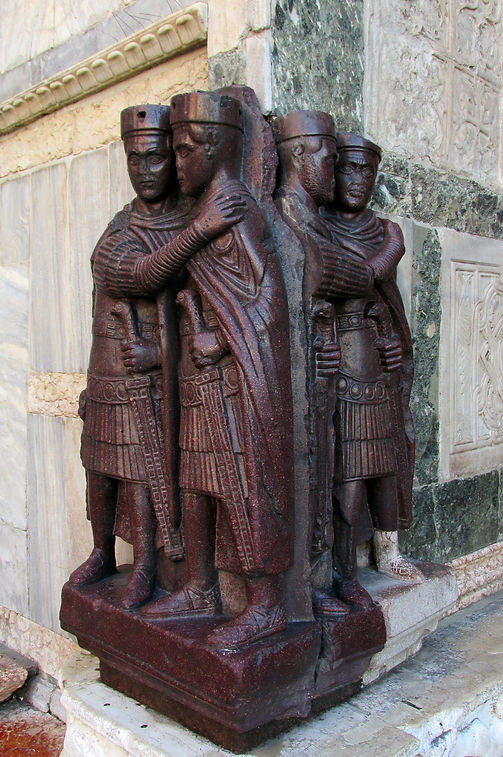The first context of the column is unknown (perhaps first in Nicomedia). In a second phase it was used in Constantinople, probably as statues of the sons of Constantine embracing one another and made of porphyry’ mentioned in the ancient sources on a place called after them Philadelphion. A part of the missing foot has been found in 1965 in the excavations of the rotunda near the Myrelaion church in Istanbul. With the loot of the fourth crusade of 1204 the group came to Venice and was inserted into the facade of San Marco.
The emperors stand and are united in an embrace. They wear the long-sleeved tunica, muscle cuirass, paludamentum and swords like the tetrarchs in the Vatican. New elements of late antique imperial ornatus have been introduced: a gem-studded belt, gem- studded swords and the new kind of shoes, campagi, adorned with gems. In a kind of anti-climax they wear the pilleus pannonicus, a traditional military cap of Illyricum made of leather or fur. The original fibulae on the shoulders of the right emperor of both groups have been chiseled out and replaced by bigger rectangular ones (probably in stucco) which are now missing. Holes in the front and back of the caps have probably served to fasten diadems with jewels in this same phase of reuse of the sculptures. The hole on the back of the cap of the right figure in the group of the Augusti is hidden in the incrustation of the wall, so these changes on the caps (as well as on the fibulae) must have taken place before the figures were brought to Venice, but after their use in a tetrarchic context - that is at Constantinople.
In these groups there are differences between two older, more rugged emperors and two younger ones with less lined faces. The differences are much less pronounced than in the Vatican groups. All the heads lack the typical characterization of hair and beard by short regular incisions, which are visible in the Vatican groups and in other images of tetrarchs in porphyry (see Galerius in the Egyptian Museum). The hair is smooth in all cases, but in both groups the emperor on the proper right has a beard made by wavy and irregular incisions, whereas the others have smooth cheeks. This has led to a variety of discussions: does each group represent an Augustus and a Caesar rather than one represent two Augusti and the other two Caesars; do the groups represent constellations of the early or late tetrarchic period; or did they possibly represent members of the family of Constantine from the beginning.
The seeming lack of beards cannot be understood as an indication for an original date in the late tetrarchic period or as an indication of a shift to the fashion of shaving before Constantine or for an even later date. The groups are tetrarchic and show the Augusti and the Caesares as the groups in the Vatican.
The group was cut vertically in the middle. Part of its proper right figure is missing as well as the proper left foot of the other (proper left) figure and the proper left side of the console. The fragments of the columns at the back of the groups allow for a reconstruction their diameter and thus the height of the columns of about 7 meters.
The Pietra del Bando is a truncated porphyry column on the southwest corner of San Marco. It is where Venetian officials once stood to issue proclamations.
Source
Porphyry group of armoured Tetrarchs (Oxford Last Statues of Antiquity)
San Marco, Byzantium, and the Myths of Venice edited by Nelson and Maguire
Resources
Venice Album (Byzantine Legacy Flickr)
Tetrarchs of Venice Album (Byzantine Legacy Flickr)



